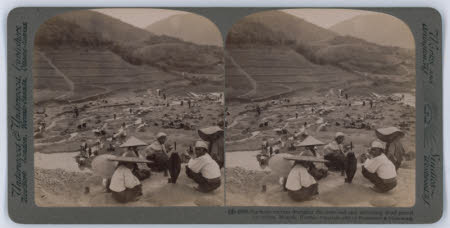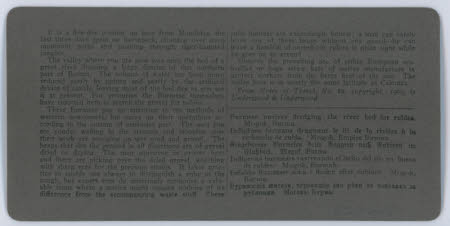Burmese natives dredging the riverbed and searching dried gravel for rubies, Mogok, Burma.
Underwood & Underwood
Category
Photographs
Date
1890 - 1910
Materials
Card
Measurements
Card size 88 x 178 mm
Order this imageCollection
Fox Talbot Museum, Wiltshire
NT 1520668.11
Summary
An albumen print stereograph depicting Burmese workers dredging the riverbed and searching dried gravel for rubies, Mogok, Burma. The print is mounted on stiff, curved, grey card with rounded corners. The images have arched tops and square bottoms. Recto: Printed in black in on the right lower margin: '(3) 8826 Burmese natives dredging the riverbed and searching dried gravel for rubies, Mogok, Burma.' 'Copyright 1904 by Underwood & Underwood.' In the left and margin, printed in italic print in black ink: "Underwood and Underwood Publishers New York, London, Toronto - Canada, Ottawa - Kansas. In the right hand margin: "Works and Studios Arlington, N.J., Westwood, N.J Verso: It is a five-day journey up from Mandalay, the last three days spent on horseback, climbing over steep mountain paths and pushing through tiger-haunted jungles. The valley where you are now was once the bed of a great river draining a large district of this northern part of Burma. The volume of water has been much reduced partly by nature and partly by the artificial device of canals, leaving most of the bed dry as you see it at present. For centuries the Burmese themselves have resorted here to search the gravel for rubies. These Burmese pay no attention to the methods of western newcomers but carry on their operations according to the custom of centuries past. The men you see yonder wading in the streams and stooping over their work are scooping up wet sand and gravel. The heaps that dot the ground in all directions are of gravel dried or drying. The men squatting in groups here and there are picking over the dried gravel watching with sharp eyes for the precious stones. It takes practice to enable one always to distingush a ruby in the rough, but expert eyes do unerringly recognise a valuable stone where a novice might suspect nothing of its difference from the accompanying waste stuff. These ruby hunters are exceeding honest, a man can safely leave one of these heaps any guard - he can leave a handful of sorted-out rubies in plain sight while he goes on his errands. Observe the prevailling use of either European umbrellas or huge straw hats of native manufacture to protect workers from the fierce heat of the sun. The valley here is in nearly the same latitude as Calcutta. From notes of travel No 19, copyright 1905, by Underwood & Underwood In English French German Swedish Spanish and Russian
Provenance
Part of The Fenton Collection. A gift from British Film Institute in 2017. From 1986-1999, part of BFI collection for the Museum of the Moving Image. BFI purchased collection in 1986 from James Fenton's Museum of Photography, Port Erin, Isle of Man 1976-1986
Makers and roles
Underwood & Underwood, photographer and publisher

